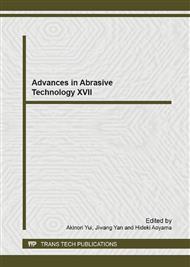p.741
p.747
p.753
p.758
p.764
p.770
p.776
p.782
p.788
Modeling and Simulation of Surface Topography Evolution in Electrical Discharge Machining (EDM)
Abstract:
This paper aims to quantify the effects of the machining condition on the surface topography in electrical discharge machining (EDM), including pulse current, pulse duration and so on. Firstly, the heat source of a single electrical pulse is defined by Gauss distribution, and the thermal effects of machining parameters on the workpiece material erosion are simulated by Finite Element Method (FEM) package ANSYS. Then, the crater size of a single pulse is numerically simulated based on the thermal model of a single pulse discharge. Furthermore, the superposition of multiply craters created by continuous pulse discharges in a random distribution is calculated by MATLAB software program, so that the evolution of the surface topography can be obtained with the combination of FEM simulation and topology calculation. In this way, the surface roughness is quantitatively calculated from the specified EDM parameters.
Info:
Periodical:
Pages:
764-769
Citation:
Online since:
September 2014
Authors:
Price:
Сopyright:
© 2014 Trans Tech Publications Ltd. All Rights Reserved
Share:
Citation:


